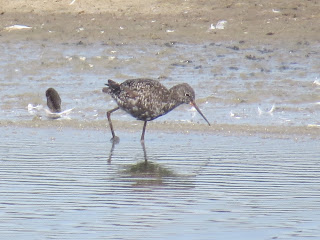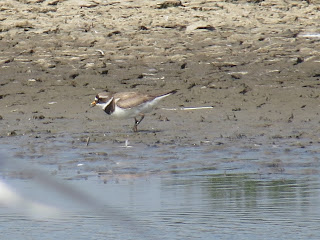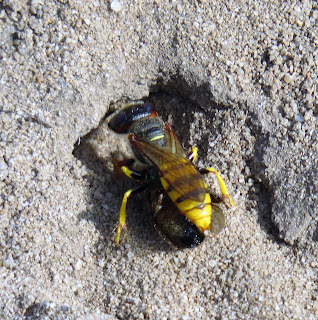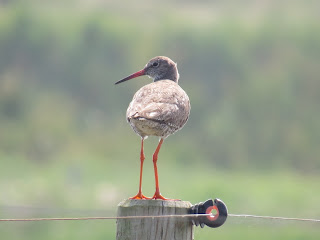 |
| Robin |
There was a perfect blue sky with warm sunshine this morning as I was dropped off early at Minsmere for a walk. The buddleia bushes were already full of butterflies and bees as I waited for the visitor centre to open. It all seemed like a perfect summer's day, however, thunderstorms were forecasted towards lunchtime and it was best to make the most of the nice weather before the storms arrived.
 |
| Red Admiral |
 |
| Small Copper |
 |
| Bee-wolf |
While setting off towards the beach and the hides, I had one of my invertebrate targets that I wanted to see. A section of the main path was riddled with the nesting holes of bee-wolves. A bee-wolf is a large solitary wasp that captures bees by paralysing them to place down a hole, where the young wasp larvae will develop and feed on them. There are many of these wasps in this one section of pathway, busy digging holes or dragging their victims between their legs down into one, but though this is a colony, this isn't one ruled by a single queen. They are all rivals as well as neighbours and work for their own needs. This pathway can be like a battlefield as well as a town, each battling for it's own tiny plot of land, which is also shared with other wasp species. It is rather fascinating to watch this 'wasp town' at work.
 |
| A different species of digger wasp |
 |
| Horsefly (I think) |
 |
| Linnet |
 |
| Cinnabar Moth Caterpillars |
 |
| Common Tern |
At the scrapes, there seemed to be fewer birds than there were from my previous visit. Most of the noisy gulls were now gone and the baby boom seems to have finished for the most part. But with that said, there were, however, plenty of common terns and a handful of sandwich terns around with growing chicks to feed. It was the terns that were making the most noise today as they commute back and forth to the sea. On the wader front, there were several avocets, black-tailed godwits, dunlins, lapwings and the odd oystercatcher, redshank, spotted redshank, common sandpiper and ringed plover.
 |
| Dunlin |
 |
| Black-tailed Godwit |
 |
| Black-tailed Godwit |
 |
| Spotted Redshank |
 |
| Ringed Plover |
 |
| Common Sandpiper |
 |
| Common Redshank |
 |
| Oystercatcher |
 |
| Mediterranean Gull |
 |
| Marsh Mallow |
Walking the circuit round the scrapes and past the sluice gates, the beautiful flowers of marsh mallows lines either side of the path for most of the way back. The path was like a long avenue of pink. A wonderful sight, but the best part was finding this big green caterpillar crawling out of it to cross to the other side of the path. I couldn't believe my eyes when this guy appeared, as this was the caterpillar of an emperor moth!

 |
| Emperor Moth Caterpillar |
 |
| Bittern |
After lunch at the visitor centre, I went to Bittern Hide in the hope of seeing the purple heron that had been seen twice there earlier this morning. But the weather had suddenly changed. The storm clouds were rolling in and the feeling of rain was imminent. I entered the crowded hide with time to spare before the heavens really came down. Just before it did, however, a bittern was spotted peeking it's head out of the centre of a bridge of sedges that split the water into two pools. It was standing tall for some time until the rain lashed it down and the thunder roared. The bittern disappeared back into the sedges, trying it's best shelter from the storm. Streaks of lightning lights up the sky as the rain fell even harder on cue to a loud thunderclap, which vibrated the entire hide. The shakes increase with every rumble as the storm moves directly above us. Windows were closed in unison to keep the hammering rain out, but were soon open again after the storm passed and we were treated to a marsh harrier doing a food pass to it's three fledged chicks. An epic end to a good day at Minsmere.








 |
| Stormy scenes! |
 |
| Rain! |
 |
| Lots of rain |
 |
| Marsh Harriers |




























































No comments:
Post a Comment